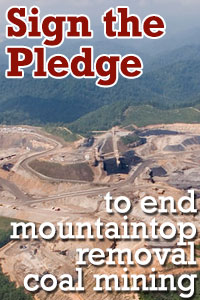News, Press Room
The Myth of Mountaintop Removal Reclamation
Monday, May 17th, 2010
FOR IMMEDIATE RELEASE
THE MYTH OF MOUNTAINTOP REMOVAL RECLAMATION
New Research by NRDC and Appalachian Voices Shows Extent of Mining and Exposes the False Promise of Post-Mining Restoration
– – – – – – – – – – –
CONTACTS:
Rob Perks, NRDC, 202-286-7435 or rperks@nrdc.org
Matt Wasson, Appalachian Voices, 828-773-0788 or matt@appvoices.org
Mick McCoy, KFTC, 606-298-4458
Lorelei Scarbro, CRMW, 304-854-2002
– – – – – – – – – – –
Reclamation FAIL report available at:
http://ilovemountains.org/reclamation-fail/
WASHINGTON (May 17, 2010) – Roughly 1.2 million acres, including 500 mountains, have been flattened by mountaintop removal coal mining in the central Appalachian region, and only a fraction of that land has been reclaimed for so-called beneficial economic uses, according to new research by environmental groups.
A study by Appalachian Voices, which analyzed recent aerial imagery of eastern Kentucky, southern West Virginia, southwest Virginia and eastern Tennessee, confirms for the first time the extent of mountaintop removal throughout the region; nearly half of which has taken place in Kentucky.
“The fact that coal companies can blast away the tops of 500 of the oldest and most biodiverse mountains on the continent shows an utter disrespect for the communities that have to live with the destruction of their land, air and water,” said Matt Wasson, with Appalachian Voices.
The mining industry has long exploited a federal statutory provision that exempts them from restoring the land to its “approximate original contour” if there is a plan to develop the land for “equal or better economic use” such as “industrial, commercial, residential or public use.” However, NRDC’s analysis – released today in its report Reclamation FAIL – confirms that nearly 90 percent of mountaintop removal sites have not been converted to economic uses.
“Mining companies don’t love mountains but they love bragging about how they restore mine sites for the benefit of local communities,” says NRDC’s Rob Perks. “Our study exposes Big Coal’s broken promises by proving that post-mining economic prosperity is a big, flat lie.”
NRDC examined 500 mountaintop removal sites in Kentucky, West Virginia, Virginia and Tennessee. Of these locations, 90 were excluded from the study due to active, ongoing mining activity. Of the 410 remaining sites surveyed:
- 366 (89.3 percent) had no form of verifiable post-mining economic reclamation excluding forestry and pasture
- 26 (6.3 percent of total) yield some form of verifiable post-mining economic development
Only about four percent of mountains in Kentucky and West Virginia, where 80 percent of the mining is occurring, had any post-mining economic activity. Virginia had the highest proportion of economic activity on its reclaimed mountaintop removal sites at 20 percent. Tennessee, which has relatively little mountaintop removal compared to the other three states, had no economic activity on the six sites examined in that state. Overall, economic activity occurs on just 6 to 11 percent of all reclaimed mountaintop removal sites surveyed as part of this analysis.
“This research shows what a sacrificial lamb Kentucky has been for an industry that is not interested in any kind of restoration,” said Mick McCoy, a member of Kentuckians For The Commonwealth, noting that Kentucky has more destroyed mountains and acreage than other states. “Here in Martin County, more than 25 percent of the land has been leveled by coal companies yet we are among the poorest of counties not just in Kentucky, but the entire country.”
“We watch our Appalachian communities being destroyed every day with the false promise of reclamation,” said Lorelei Scarbro, with Coal River Mountain Watch in West Virginia. “We, the citizens living at ground zero are losing our way of life and our history with every mountain they take. I am heartbroken to think what my grandchildren will have left when they grow up if we don’t stop this rogue mining.”
###
The Natural Resources Defense Council is a national, nonprofit organization of scientists, lawyers and environmental specialists dedicated to protecting public health and the environment. Founded in 1970, NRDC has 1.3 million members and online activists, served from offices in New York, Washington, Chicago, Los Angeles, San Francisco and Beijing. To learn more about NRDC’s campaign against the world’s worst coal mining, visit: NoMoreMountaintopRemoval.org
Appalachian Voices is a regional, non-profit organization that brings people together to solve the environmental problems having the greatest impact on the central and southern Appalachian Mountains with offices in Boone, NC; Charlottesville, VA; and Washington, DC. To learn more, visit: AppalachianVoices.org










February 13th, 2011 at 2:28 am
It’s really odd. It’s not OK for mining companies to destroy these rich forests because…..there’s no economic growth there afterward? If all the over 1,000,000 mined acres were used for rampant development and “economic growth” without mining would that be any more acceptable? Kinda missing the point aren’t you? A priceless forest second to the Amazon in diversity is being treated like GARBAGE!